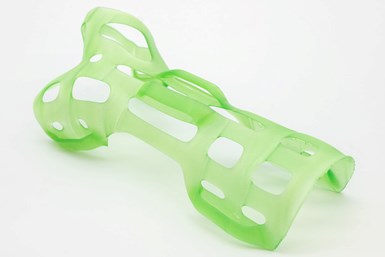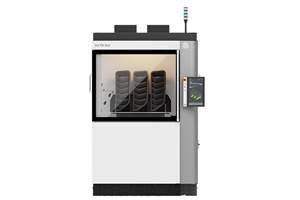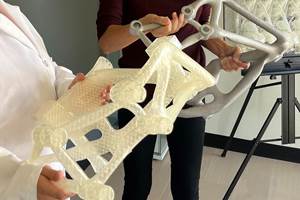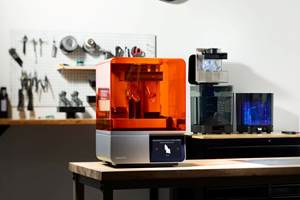Altana Launches 10 Resin-Based Cubic Ink Materials for 3D printing
The new resins in the Cubic Ink family of 3D printing materials are focused on system-open and industry-applicable additive manufacturing across DLP, LCD and SLA technologies.
Altana says it is giving shape to new ideas by enabling additive manufacturers to turn product designs into reality with its new and enhanced resin-based Cubic Ink 3D printing materials. Among them is a material for stereolithography (SLA) applications — Cubic Ink High-Performance 2-1400 VP.
With the new products, specialty chemicals group Altana says it is significantly extending its Cubic Ink 3D printing material family for high-performance resins. The expansion positions the company as a supplier of manufacturer-independent, open-system materials suitable for Digital Light Processing (DLP), Liquid Crystal Display (LCD) and SLA applications, as well as inks for material jetting.
The company says this development unlocks entirely new opportunities for users, particularly in the automotive and aerospace sectors. It is also a boon for the medical technology field, encompassing audiology, dental medicine and orthopedics as it can enhance their product manufacturing processes.
“Altana is focusing its Cubic Ink family of 3D printing materials on system-open and industry-applicable additive manufacturing across DLP, LCD and SLA technologies,” says Dr. Max Röttger, head of Cubic Ink. “Our customers reap the rewards of our extensive solution expertise in pioneering high-performance materials. Furthermore, we offer dedicated support to our customers in the development and formulation of high-performance inkjet inks for material jetting.”
Mold 210 VP and 601 VP are two materials in the Cubic Ink series which were designed for resin printing. These materials offer a multitude of advantages in both the printing process and postprocessing stages. The materials are used, for example, in the manufacture of hearing aids. Their low viscosity enables rapid printing, and the printed molds can be effectively cleaned using common washing solvents, such as IPA. Furthermore, after approximately 10 minutes of UV post-exposure, these materials are ready for filling with the corresponding molding compound.
Another innovative material is the Cubic Ink High-Performance 4-1301 VP for medical technology applications. The material has been tested for its non-cytotoxic properties by accredited testing laboratories for medical technology. The results of these tests show the material is well-suited for medical technology applications with direct skin contact, such as orthoses for fingers or arms.
Cubic Ink High Performance 4-2800 VP-ESD debuts in the segment of electrostatic dissipative materials (ESD)-compliant, or antistatically designed, printing materials. The resin is engineered for crafting items that possess electrostatic dissipative properties, effectively mitigating the risk of sudden voltage discharges in sensitive electronic components. These materials are used primarily in the handling and manufacture of electrical or electronic components, shielding them from damage caused by uncontrolled electrostatic voltage discharges.
This resin can be processed efficiently and swiftly because of its low viscosity. After printing, it can be cleaned with water and exhibits commendable mechanical properties following posttreatment. It also has good reactivity and electrical conductivity, with a surface resistance of 1.8 × 107 Ωcm, as measured under laboratory conditions.
Cubic Ink High-Performance 4-2100 VP features exceptional impact strength and heat resistance. This low-viscosity material enables fast and precise printing, while its flexibility makes it especially well suited for the manufacture of production aids, including sturdy internal components for industrial grippers.
- To learn more about the multitude of materials used in additive manufacturing, check out our Materials section.
- Read more about Material Jetting in this overview from Tim Simpson, a Paul Morrow Professor of Engineering Design & Manufacturing at Pennsylvania State University.
Related Content
3D Systems’ SLA 750 for Cost-Effective SLA Batch Part Production
Rapid + TCT 2022: The system features the SLA 750 and SLA 750 Dual — which the company says is the first synchronous, dual-laser stereolithography printer.
Read MoreIntrepid Automation: How Investment Casting Benefits From High Speed DLP
Vat polymerization 3D printing for investment casting patterns offers a way to deliver design freedom at production speed.
Read MoreEvonik Adds Three Infinam Photopolymers to Product Portfolio
Formnext 2022: These photoresin products are for use in common UV-curing 3D printing processes such as stereolithography (SLA) or Digital Light Processing (DLP).
Read MoreFormlabs’ Form 4 3D Printer Offers New Levels of Reliability and Speed for Stereolithography
The Form 4 is designed to deliver most parts in less than two hours, offering users a powerful, affordable tool to bring ideas to life at fast speeds with excellent reliability, print quality and ease of use.
Read MoreRead Next
GE Additive Rebrands as Colibrium Additive
As part of the brand name transition, both the Concept Laser and Arcam EBM legacy brands will be retired.
Read MoreTo Improve Performance of Compression Molded Composites, Add 3D Printed Preforms
9T Labs' Additive Fusion Technology enables the manufacture of composite structures with as much or as little reinforcement as is necessary, using 3D printed continuous fiber preforms to add strength just where needed.
Read MoreVideo: Intelligent Layering Metal 3D Printing at 3DEO
Contract manufacturer 3DEO delivers metal parts using Intelligent Layering, a binder jetting-like 3D printing process the company developed and operates internally. Here’s how it works.
Read More











.png;maxWidth=300;quality=90)












